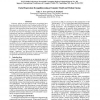Free Online Productivity Tools
i2Speak
i2Symbol
i2OCR
iTex2Img
iWeb2Print
iWeb2Shot
i2Type
iPdf2Split
iPdf2Merge
i2Bopomofo
i2Arabic
i2Style
i2Image
i2PDF
iLatex2Rtf
Sci2ools
ICCV
1995
IEEE
1995
IEEE
Facial Expression Recognition Using a Dynamic Model and Motion Energy
Previous efforts at facial expression recognition have been based on the Facial Action Coding System (FACS), a representation developed in order to allow human psychologists to code expression from static facial “mugshots.” In this paper we develop new, more accurate representations for facial expression by building a video database of facial expressions and then probabilistically characterizing the facial muscle activation associated with each expression using a detailed physical model of the skin and muscles. This produces a muscle-based representation of facial motion, which is then used to recognize facial expressions in two different ways. The first method uses the physics-based model directly, by recognizing expressions through comparison of estimated muscle activations. The second method uses the physics-based model to generate spatio-temporal motion-energy templates of the whole face for each different expression. These simple, biologically-plausible motion energy “temp...
Computer Vision | Facial Action Coding System | Facial Expression Recognition | Facial Expressions | ICCV 1995 |
Related Content
| Added | 26 Aug 2010 |
| Updated | 26 Aug 2010 |
| Type | Conference |
| Year | 1995 |
| Where | ICCV |
| Authors | Irfan A. Essa, Alex Pentland |
Comments (0)

